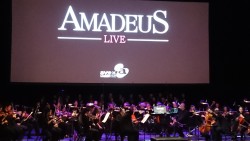
Although I hadn’t seen the film before, the content is familiar because, oddly enough, of The Simpsons. In the episode Magical History Tour, there’s a segment building on the myth of conflict between Salieri and Mozart. In The Simpsons, it was Bart as Mozart and Lisa as Salieri. The episode clearly demonstrates influence from Amadeus and playwright Peter Shaffer’s fictional approach to these very real people. And this is where Amadeus and its story hit a weird bump: the dramatic tension that makes the film so enjoyable – Salieri and Mozart – is not true.
Film screenwriter Peter Shaffer required a strong commentary of Mozart, and what better character for that than Salieri, a fellow composer shadowed behind Mozart’s spotlight. In doing so, Shaffer made deliberate choices to diminish Salieri’s influence, skill and legacy. It is this organic conflict of Salieri that drives the drama of the film. Mozart is a one-dimensional “creature-child” and to make him interesting, Salieri must be compelling; Shaffer chose to do this by artificially diminishing Salieri.
In the pre-talk before the Sony Centre showing, Ian Kyer, a self-appointed master of Salieri, provided insight on the dynamics of the film. There is a very interesting lineage of this story that has impacted art over the centuries since Mozart’s death in 1791. In 1830, Alexander Pushkin wrote Mozart and Salieri, which was then made into an opera by Nikolai Rimsky-Korsakov in 1897. Peter Shaffer then adapted the story into his play Amadeus in 1979. It became a film in 1984. Kyer has devoted much of the last decade to recasting Salieri as more than portrayed in the film – an eminent musician, scholar, composer, and most of all, teacher of his time.
Throughout the film, core moments in the story are marked with Mozart’s operas. (Oddly enough, his symphonies and concertos only make passing notice in the film.) The operas selected follow roughly a chronological pacing of the story, which lends itself very well to the dramatic energy of the film: The Abduction from the Seraglio makes a strong showing in the first half of the film as Mozart begins to enter the Court of the Holy Roman Emperor Josef II, The Marriage of Figaro is used to illustrate Mozart’s commitment to telling new stories against opposition, and Don Giovanni shapes a powerful interpretation of Mozart’s thoughts and feelings on the death of his father. The final opera we encounter is indeed Mozart’s last, and quite possibly his most beloved – The Magic Flute.
The second half of the film is dominated by the Requiem Mass. The Toronto Mendelssohn Choir shone the most in these pieces – after all, they know it well. Despite best efforts the diction was lost in the Sony Centre, but the overall effect was not diminished; it is the reality of singing amplified in a space full of soft services and full with 3100 patrons. The choir had excellent blend and balance and was well met by the Motion Picture Symphony Orchestra.
Those familiar with the film might know of the scene with Mozart dictating notation to Salieri from his bed. Mozart’s descriptive explanation of the compositional elements of the Confutatis of the Requiem in the film was exceptionally interesting with the presence of a live orchestra and choir. The scene serves as a tricky demonstration that melds together one of the most dramatic moments of the entire mass while at the same time enlightening our understanding of Mozart’s composition.
Richard Kaufman – a world-renowned conductor and specialist in film music, who serves as the principal pops conductor of the Orange County Pacific Symphony – helmed the musicians. I’m always surprised when conductors of live film screenings don’t use a click track with their musicians for consistency. Without, a performance requires a deep mastery and familiarity to stay cohesive. Especially in this film; scene changes are sudden and tied often to abrupt endings of songs. Kaufman, without a click track, was a clear and definitive leader in this work. The remarkable achievement of a well-done live movie-and-music presentation is that you forget that the music is being performed separately. It becomes seamless and ordinary, simple and effortless. And to get to that point a production requires years of musical experience, top-notch musicians, and a strong visual, auditory and kinesthetic linkage. A good deal of this was in Kaufman’s hands on October 28, and the musicians were not led astray.
There’s a reason why Mozart continues to captivate so many, centuries after his time. The work is magnificent. Countless tributes influenced by his work will always continue to make Mozart’s music effective and relevant: the Toronto Symphony Orchestra’s Mozart festival every year in January, the namesake Amadeus Choir, Opera Atelier’s many period productions, and the Canadian Opera Company’s years of interpreting his work are some examples – just in Toronto alone – of music presenters who continue to keep the great legacy of this composer alive. And there is ultimately where I have the biggest issue with the portrayal of Mozart and his music in the film. Mozart’s magic wasn’t just in his head and ego; it was put to paper, given life and shared. And that’s why, 261 years later, across the globe, in a city with diversity that Mozart had never known, I can sit with my score in North Scarborough and sing along to his work. Music is an invitation, and we only have to reach out and accept it.
Amadeus Live was presented at the Sony Centre for the Performing Arts on October 28 and 29, featuring the Motion Picture Symphony Orchestra and Toronto Mendelssohn Choir conducted by Richard Kaufman.
Follow Brian Chang on Twitter @bfchang. Send info/media/tips to choralscene@thewholenote.com.


